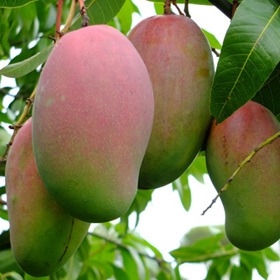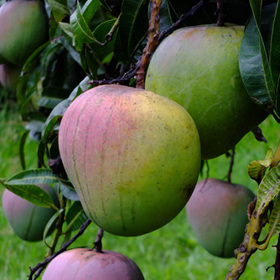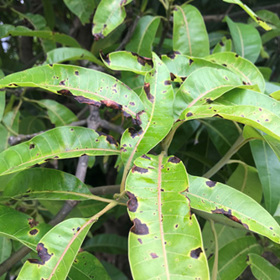Mangoes
BackMangoes are simply one of the best things about summer with their smooth, sweet, juicy flesh. Mango trees thrive in the tropics and subtropics where summers are long and hot but with the right variety and positioning they can be grown in temperate areas too. Also don’t be put off by the tree size. There are dwarf varieties available that only get to about 4m tall but even the regular large growing varieties can be contained comfortably in an average sized backyard with proper pruning.
‘Kensington Pride’, which is commonly referred to as the Bowen mango due to its origin, is among the best-known varieties but there are many more to discover in a range of shapes, colours and flavours. Most are sold as grafted trees that flower and fruit within three years. ‘Kensington Pride’ can also be purchased as a seed grown tree or started at home from seed and will produce fruit within six years of planting.
How to Grow Mangoes
Mango trees need a frost free, sunny position where the soil is well drained. In cooler areas, place them in a spot where they’ll also be protected from cold winter wind and rain.
To prepare the soil, incorporate a generous amount of compost over an area of about 1.5-2m wide. If the soil is heavy apply gypsum and create a raised mound to improve drainage.
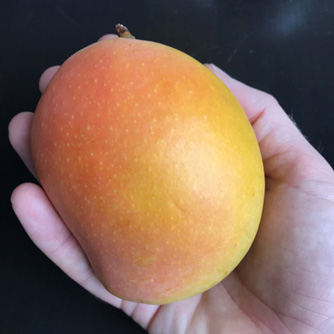
Ripe 'Kensington Pride' mango
In tropical and subtropical areas, mango trees can be planted in all year around provided it’s warm. In warm temperate regions plant in spring as conditions warm up which gives the tree time to settle in before the cool of winter arrives. After planting, water in with OCP eco-seaweed then mulch with straw or sugar cane mulch.
Growing a ‘Kensington Pride’ Mango from Seed
A seed from a ‘Kensington Pride’ mango will reliably grow into a tree with the same qualities as its parent (true-to-type). In addition the seed is poly-embryonic which means it has multiple embryos so the seed from a single fruit will product multiple plants.
Take a store-bought Kensington Pride mango and remove as much flesh as possible to expose the seed. Make note of the end of the seed that corresponds with the stem end of the fruit. Next, the hard seed coating needs to be removed. On a chopping board cut off the very tip of the seed (at the stem end) to make a small opening. Carefully insert a bread knife and twist to open the seed casing a little more, then use hands to pry it open completely. Take care not to damage the embryos inside.
Separate the embryos and plant them individually in small pots filled with premium potting. Place the kidney shaped embryos just below the surface with the concave side facing downwards. Position pots in a warm, semi-shaded spot and keep the mix just moist. The seeds will germinate in two weeks or so.
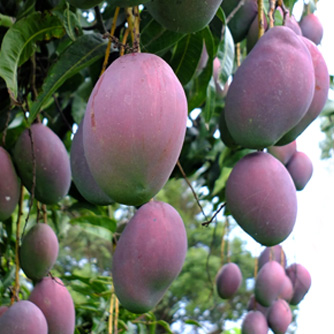
'Irwin' mango
As they develop, one of the seedlings will be stunted and generally weaker than the others. This will have grown from a fertilised embryo and should be thrown out. The remaining seedlings will be true clones of the parent. Fertilise fortnightly with OCP eco-aminogro and OCP eco-seaweed to encourage strong growth. When the roots have filled the pot, plant the seedling in the ground or pot up to a larger container for growing on.
Note that if you try this with other mango varieties they also need to be poly-embryonic otherwise there’s no guarantee of getting a good fruiting tree as the seeds won’t grow true to type.
Fertilising and Maintaining Mangoes
Water mango trees regularly in the first year or two. Once established they survive on natural rainfall in most areas but will appreciate a deep soaking during extended dry periods. Maintain a layer of organic mulch beneath the canopy to conserve moisture and reduce weed competition.
Fertilise in spring with an organic fertiliser (pellets, blood and bone, manure etc.) and again after harvesting fruit in summer. Apply OCP eco-aminogro and OCP eco-seaweed fortnightly around the roots or as a foliar spray to give the tree an extra boost.
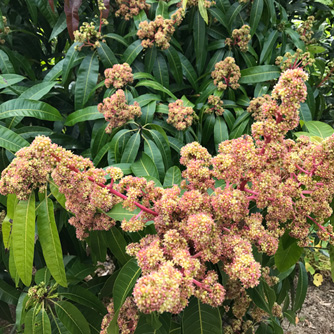
Mango flowers
Pruning Mangoes
A young tree should have the top cut off about 1m above the ground to encourage branching and then trim the tips of the regrowth over the following 2-3 years to encourage the tree to develop compact bushy growth.
Prune established trees annually immediately after harvest to maintain desired size and shape. Remove vigorous upward growth and shorten any side branches that are getting too long. Mangoes flower on the ends of branches so lightly trim the tips of all remaining branches to encourage more shoots and more flowers to form the following season.
Harvesting Mangoes
Depending on location, flowers appear from winter to spring. Fruit mature in September/October in northernmost parts of Australia, January in south east Queensland and February in southernmost growing areas. Fruit are ready to start picking when they have developed a plump rounded shape with a colourful blush. To test, remove a few and allow them to continue ripening in a warm shaded spot. If they ripen nicely, with good flavour and texture, continue picking. Fruit can be left to fully ripen on the tree but they become more susceptible to pest and disease problems so it’s best to harvest a bit early. Cut or snap the fruit stem leaving a 5-10cm piece of stem on the fruit. This reduces the risk of oozing sap spoiling the skin of the fruit.
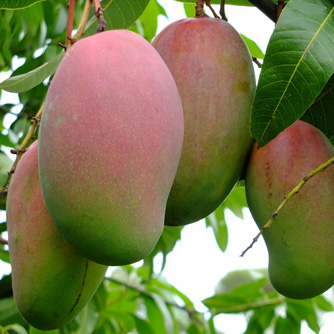
'Valencia Pride' mango
Pests and Diseases of Mango
- Anthracnose – this fungal disease creates black markings on fruit and leaves, causes flowers to rot and fruit to fall prematurely. It is most common in wet and humid conditions. To reduce problems prune to remove dead wood and thin and reduce the tree canopy to increase airflow. Regularly foliar sprays of OCP eco-aminogro and OCP eco-seaweed will boost the health of the tree to help reduce the incidence of disease. If the problem persists then you’ll need to spray with an organic fungicide.
- Powdery mildew – look out for a light grey or white coating spreading over foliage. Spray early with an organic fungicide to minimise damage.
- Scale – these sap sucking insects can weaken mango trees with heavy infestations killing leaves and branches. Spray with a horticultural oil to smother them. Monitor trees regularly and repeat applications if the pest persists. Water and fertilise trees to improve general health and boost natural defences.
- Fruit fly – fruit is ruined by the female adults laying eggs in the fruit and their maggots then feeding on the flesh. Hang the OCP eco-lure trap at the beginning of spring to monitor male flies. As soon as they appear start applying a bait spray that targets both male and female fruit flies, or set up exclusion netting/bags.
- Other pests such as fruit spotting bug, fruit piercing moth, flying foxes and possums may damage fruit. Trees kept small by pruning can be protected from all of these pests with a complete cover of fine weave netting. If you can fit your finger through it then it’s not fine enough to be safe for wildlife.
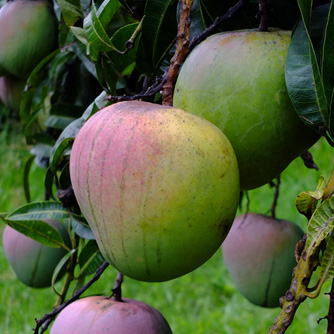
'R2E2' mangoes
Our Top Pick of Mango Varieties
Mangoes are self-pollinating so you only need one tree but you just might be tempted to grow a few different types given how delicious the fruit is!
- ‘Kensington Pride’ (also called Bowen) – Most popular commercial variety with delicious smooth flesh. Suitable for all growing areas including cooler zones. It’s a large tree up to 8m unpruned.
- ‘Irwin’ – Smooth flesh with a rich flavour and skin which is purple to bright orange/red. Dwarf variety growing to 3m.
- ‘Florigon’ – Soft, smooth flesh with excellent flavour. Reaches 5-7m high.
- ‘Nam Doc Mai’ – This Thai variety is often eaten green in salads but is delicious when ripe too. Grows up to 6m.
- ‘Valencia Pride’ – Large long fruits that are very sweet. It’s a late season variety and reaches up to 8m.
- ‘Royal Red’ – Attractive red skin with sweet smooth flesh. It’s a semi-dwarf tree reaching 4-5m.
- ‘Palmer’ – Colourful sweet fruit that ripens late in the season. Prefers hotter areas and another dwart that only grows 3-4m.
- ‘R2E2’ – Large brightly coloured fruit with a milder flavour. Tolerates cool conditions. Grows 6-8m high.
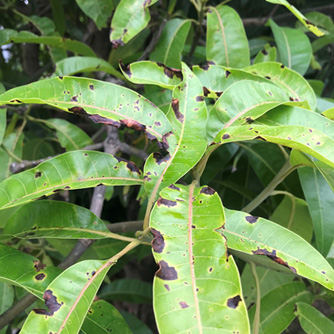
Anthracnose on mango leaves



